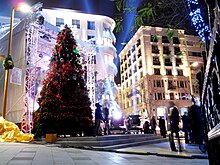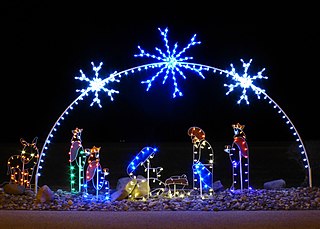
Christmas is an annual festival commemorating the birth of Jesus Christ, observed primarily on December 25 as a religious and cultural celebration among billions of people around the world. A liturgical feast central to Christianity, Christmas preparation begins on the First Sunday of Advent and it is followed by Christmastide, which historically in the West lasts twelve days and culminates on Twelfth Night. Christmas Day is a public holiday in many countries, is observed religiously by a majority of Christians, as well as celebrated culturally by many non-Christians, and forms an integral part of the annual holiday season.

A Christmas tree is a decorated tree, usually an evergreen conifer, such as a spruce, pine or fir, or an artificial tree of similar appearance, associated with the celebration of Christmas.

A holiday is a day or other period of time set aside for festivals or recreation. Public holidays are set by public authorities and vary by state or region. Religious holidays are set by religious organisations for their members and are often also observed as public holidays in religious majority countries. Some religious holidays, such as Christmas, have become secularised by part or all of those who observe them. In addition to secularisation, many holidays have become commercialised due to the growth of industry.
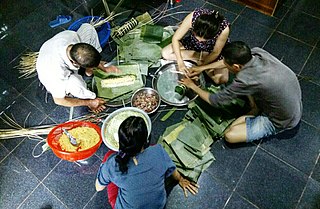
Tết, short for Tết Nguyên Đán, is the most important celebration in Vietnamese culture. Tết celebrates the arrival of spring based on the Vietnamese calendar and usually has the date in January or February in the Gregorian calendar.

In the Gregorian calendar, New Year's Eve refers to the evening, or commonly the entire day, of the last day of the year, 31 December, also known as Old Year's Day. In many countries, New Year's Eve is celebrated with dancing, eating, drinking, and watching or lighting fireworks. Some Christians attend a watchnight service to mark the occasion. New Year's Eve celebrations generally continue into New Year's Day, 1 January, past midnight.

Christmastide, also known as Christide, is a season of the liturgical year in most Christian churches.

The observance of Christmas around the world varies by country. The day of Christmas, and in some cases the day before and the day after, are recognized by many national governments and cultures worldwide, including in areas where Christianity is a minority religion which are usually found in Africa and Asia. In some non-Christian areas, periods of former colonial rule introduced the celebration ; in others, Christian minorities or foreign cultural influences have led populations to observe the holiday.

Ded Moroz, or Morozko, is a legendary figure similar to Father Christmas, and Santa Claus who has his roots in Slavic mythology. The tradition of Ded Moroz is mostly spread in East Slavic countries and is a significant part of Russian culture. At the beginning of the Soviet era, communist authorities banned Ded Moroz. However, the ban was lifted and he soon became a significant part of Soviet culture. The literal translation of DedMoroz is Grandfather Frost or Old Man Frost, but traditionally the name is translated as Father Frost.

The League of Militant Atheists, also Society of the Godless or Union of the Godless, was an atheistic and antireligious organization of workers and intelligentsia that developed in Soviet Russia under influence of the ideological and cultural views and policies of the Communist Party of the Soviet Union from 1925 to 1947. It consisted of party members, members of the Komsomol youth movement, those without specific political affiliation, workers, and military veterans.

Christmas is the celebration of the birth of Jesus Christ, which, in Western Christian churches, is held annually on 25 December. For centuries, it has been the subject of several reformations, both religious and secular.

Jul or jol is the term used for the Christmas holiday season in Scandinavia and parts of Scotland. Originally, jul was the name of a month in the old Germanic calendar. The concept of jul as a period of time rather than a specific event prevailed in Scandinavia; in modern times, jul is a period of time stretching from the fourth Sunday before Christmas Eve, December 24, to (traditionally) mid-January at the date of Epiphany with the month of December and Christmas, and the week up to the New Year, as its highlight. The modern English yule and yuletide are cognates with this term.
"A Christmas Tree and a Wedding" is a short story written by Russian author Fyodor Dostoyevsky published in 1848. The piece is narrated by a guest at a New Year's Eve ball. He observes the party's guest of honour who takes special interest in one of the children.

Novy God or Noviy God is a New Year celebration observed in Russia, in post-Soviet states, and globally by the diasporas of post-Soviet states.
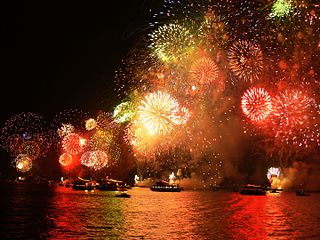
Bayram is the Turkic word for a nationally-celebrated festival or holiday, applicable to both national and religious celebrations.

Saint Sylvester's Day, also known as Silvester or the Feast of Saint Sylvester, is the day of the feast of Pope Sylvester I, a saint who served as Pope from 314 to 335. Medieval legend made him responsible for the conversion of emperor Constantine. Among the Western churches, the feast day is held on the anniversary of Saint Sylvester's death, 31 December, a date that, since the adoption of the Gregorian calendar, has coincided with New Year's Eve. For these Christian denominations, Saint Sylvester's Day liturgically marks the seventh day of Christmastide. Eastern churches celebrate Sylvester's feast on a different day from the Western churches, i.e. on 2 January. Saint Sylvester's Day celebrations are marked by church attendance at a Watchnight Mass that is often held around midnight, as well as fireworks, partying, and feasting.

Santa Claus is a legendary figure originating in Western Christian culture who is said to bring gifts during the late evening and overnight hours on Christmas Eve. Christmas elves are said to make the gifts in Santa's workshop, while flying reindeer pull his sleigh through the air.

In Ukraine, Christmas celebrations traditionally start on Christmas Eve, and last until January 6, the date of the celebration of the baptism of Jesus, known in Ukraine as Vodokhreshche or Yordan, according to the Gregorian calendar and Revised Julian calendar by the Orthodox Church of Ukraine (OCU), the Catholic Church in Ukraine and Ukrainian Protestants.
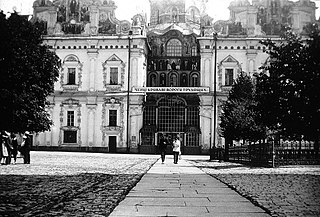
The USSR anti-religious campaign of 1928–1941 was a new phase of anti-religious campaign in the Soviet Union following the anti-religious campaign of 1921–1928. The campaign began in 1929, with the drafting of new legislation that severely prohibited religious activities and called for an education process on religion in order to further disseminate atheism and materialist philosophy. This had been preceded in 1928 at the fifteenth Party congress, where Joseph Stalin criticized the party for failure to produce more active and persuasive anti-religious propaganda. This new phase coincided with the beginning of the mass collectivization of agriculture and the nationalization of the few remaining private enterprises.
Noel Baba is the Turkish version of Père Noël, which is a widely celebrated figure for New Year celebrations, substituting Christmas Holiday in predominantly Christian countries.
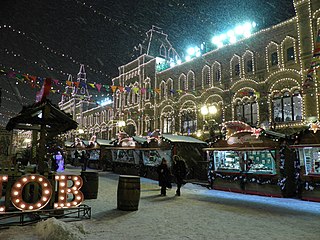
Christmas in Russia, called Е́же по пло́ти Рождество Господа Бога и Спа́са нашего Иисуса Христа in the Russian Orthodox Church, is a holiday commemorating the birth of Jesus Christ. It is celebrated on 25 December on the Julian calendar, which corresponds to 7 January on the Gregorian calendar. It is considered a high holiday by the church, one of the 12 Great Feasts, and one of only four of which are preceded by a period of fasting. Traditional Russian Christmas festivities start on Christmas Eve, which is celebrated on 6 January [O.S. 24 December].

